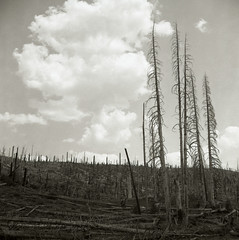Green Jobs and Investment in CaliforniaGreen Tech Summit, Yerba Buena Center, San Francisco, January 14, 2008This one-day summit was attended by nearly 800 investors, policy makers, educators, industry experts, and labor leaders to discuss investment, growth, and job opportunities in green tech. It was a very interactive and educational meeting with the primary goal to identify mechanisms to achieve tangible economic, environmental, and social benefits through California's progressive climate and environmental policies.
The summit began with opening addresses from Timothy Alan Simon, Commissioner for the California PUC, Willie Brown, former Mayor of San Francisco, and Gavin Newsom, Mayor of San Francisco.
- Amongst other things, Willie Brown said buy his "g*ddamn
book".
I missed a lot of what he said because the audience was laughing so loudly.
- Gavin Newsom basically said that San Francisco is committed to going green, and showed a very hip music video to prove it. He also mentioned some more concrete examples, including the transition to natural gas-powered taxis, the carbon neutralization of the city through the purchase of locally based carbon offsets from three SF-based trading companies, and the move toward replacing revenue from city payroll taxes by assessing carbon taxes.
Later in the day we were also treated to video feeds from California State Assembly Speaker Fabian Núñez (live) and Governor Arnold Schwarzenegger (not so live), as well as a visit from Attorney General and former Oakland Mayor Jerry Brown. Jerry Brown had some pithy advice for the forward-looking audience:
- There will be resistance to moving towards a green economy. Some people think that talking about the future is 'flaky', so try to make it all sound like yesterday.
- Try not to get too far ahead of yourself.
- The road ahead is rocky, with obstacles, and strewn with Republicans.
The first panel, moderated by Phil Angelides, Chairman of the
Apollo Alliance and former Treasurer and Democratic candidate for Governor, focused on how to prepare California for a booming green economy. The panel comprised Van Jones, Ella Baker Center for Human Rights, Peter Darbee, Chairman of the Board, CEO, and President of PG&E, Nancy Pfund, JPMorgan, Dr. Marshall Drummond, Chancellor of the LA Community College District, and Jay Hansen, Legislative and Political Director of the State Building & Construction Trades Council. The panel identified that there are large gaps between labor demand and supply, and a significant need to develop a diversified and skilled green workforce. Some key comments:
- Training and education in green technologies needs to begin with vocational training and adequate training investment, starting in primary and secondary schools, community colleges, and prisons.
- There needs to be equity in the new green workforce. The green economy should be inclusive, especially of those who were left out of petroleum-powered industry jobs.
- With only 4% of the world's population, the US accounts for 25% of the world's greenhouse gas emissions and 25% of the prison population (of those known to be incarcerated?).
The second panel, moderated by Dan Kammen of UC Berkeley, focused on how to go from investment and innovation to green jobs to meeting the state's climate change goals. The panel comprised Julie Blunden of SunPower, Nancy Floyd of Nth Power, Joseph Perkins, President and CEO of the Home Builders Association of Northern California, and Dan Reicher, Director of Climate Change and Energy Initiatives for google.org and former Assistant Energy Secretary under President Clinton. The panel proposed that in addition to private investment, there need to be government incentives to initially subsidize the green economy, just as the petroleum economy has been subsidized historically. Some key comments:
- Solar/thermal energy technology and application is growing exponentially. It is estimated that solar energy costs will decrease 50% by 2012 as compared to today's costs.
- 10% of today's venture capital dollars are going to research, development, and product innovation in new energy technologies.
- 50% of US energy still comes from coal. We need a carbon price and cap immediately.
- The easiest and largest energy efficiency gains to be made right now come from conservation.
The third session consisted of interactive break-out groups of approximately 150 people each. Each group focused on a different topic, with the goal of developing strategies and solutions that advance clean energy investment in California. My group was moderated by Jose Carmona, policy coordinator for the non-profit Center for Energy Efficiency and Renewable Technology
(CEERT). Honestly, I didn't hear any concrete solutions come out of our or the other sessions, except one guy did propose that if we could convince 14-year old girls that fuel inefficiency was really uncool, they would never date another guy who drove a Hummer, which would ultimately drive up CAFE standards.
The fourth and final panel was moderated by Bob Epstein, co-founder of Environmental Entrepreneurs (E2). This session basically verbalized the perspectives, experiences, and opinions of the panel members, who comprised Dr. Philip Day, Chancellor of City College of San Francisco, Raquel Pinderhughes, Professor of Urban Studies at SFSU, Peter Liu, founder of New Resource Bank, and Tom Martinez, Business Development Director for the National Electrical Contractors Association (NECA) and the International Brotherhood of Electrical Workers (IBEW).
The
summit hosts included the
California Public Utilities Commission, the
Willie L. Brown Jr. Institute on Politics and Public Service, the
California Clean Energy Fund, the
Ella Baker Center for Human Rights, and the
Apollo Alliance.
Other sponsors included Manatt, PG&E, Southern California Edison, Morrison Foerster, Cal-Am, Independent Energy Producers Association, Goodin MacBride Squeri Day & Lamprey LLP, Constellation NewEnergy, Merriwether & Williams Insurance Services, Shell, Blaylock & Co., Grant Capital Management, Renewable Energy Marketing Board, Woodside Natural Gas, EnXco, Bloomenergy, Navigant Consulting, and many others.
And here's a
link to an article about the summit published last week in the SF Chronicle.





 The results are in.
The results are in.